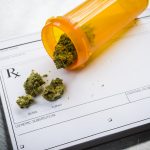The claim that THC is recreational only and has no medicinal value is bogus. It is time to move on from the “Reefer Madness” propaganda.
Delta-9-tetrahydrocannabinol (THC) is the most prominent cannabinoid in the cannabis plant and is responsible for the psychoactive “high” effects. The THC molecule was not isolated until 1964 but our ancestors utilized THC-rich cannabis for its many medicinal effects. The claim that THC is recreational only and has no medicinal value is bogus. It is time to move on from the “Reefer Madness” propaganda. Many medical cannabis patients report significant and life-changing relief of medical conditions with THC-rich cannabis.
All humans have an endocannabinoid system which relies on the synthesis of endocannabinoid compounds, often referred to as our “inner cannabis,” which bind to receptors on our cells in a key and lock fashion. The role of this system is to maintain balance — homeostasis — of the cells in our brains and bodies. Mood, appetite, sleep, immune function and other important physiologic functions are under control of the endocannabinoid system. This system cannot function well if one cannot make enough endocannabinoids, resulting in an “endocannabinoid deficiency.” The causes of endocannabinoid deficiency are many: genetically inherited or a result of illness, chronic stress, sleep deprivation, and other causes. The deficiency causes cells to remain in an imbalanced state. Mother Nature gives us the cannabis plant that is full of phytocannabinoids which can replace the deficiency naturally, with THC mimicking the effects of the endocannabinoids, resulting in balance.
Scientifically, THC is made up of carbon, hydrogen, and oxygen atoms in a three-ring structure. The cannabis plant is thought to make THC in its flower as a defense mechanism and as UV protection. THC is a result of the decarboxylation of tetrahydrocannabinolic acid, which occurs when the flower is heated. The potency of the cannabis plant is usually measured by the content of THC, which can range from 0.5% up to ~30%. Concentrated forms of THC-rich cannabis can have potencies up to ~90%. The average potency of cannabis in the 1970s was 2-5% and now ranges between 10-25% in states with medical cannabis laws.
THC is the most studied of the phytocannabinoids. It binds directly to the two types of cannabinoid receptors located in our brains and bodies, mimicking our natural endocannabinoids. In addition to relieving pain and increasing appetite in patients, THC has also been shown to be a potent anti-inflammatory, antioxidant, antidepressant, antianxiolytic, neuroprotectant, anti-proliferative (kills cancer cells), anti-nausea and anti-emetic (stops vomiting). Although psychoactivity is the most famous effect, it can be avoided using low-dose THC products that are currently available. These products allow for THC dosing of about 1 – 10 mg, giving patients better control over the effects and permitting for careful experimentation to find the right dose. Multiple long-term studies document the excellent safety profile of THC-rich cannabis, with the DEA’s own judge, Francis Young, calling it, “one of the safest therapeutically active substances known to man.” Tolerance to the effects of THC can develop with higher doses and long-term use but are easily reversed with abstinence.
There are a few things to keep in mind when using THC-rich cannabis medicine:
THC-rich cannabis alleviates many symptoms and medical conditions with little to no side effects. Its use is growing exponentially as we move toward science- and evidence-based research and away from propaganda. Knowing your medicine is the best way to find success with it.
(1163)





Leave A Reply